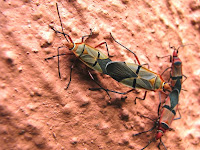Before I leave on another tour again I'd like to add what I believe is the cutest of caterpillars = an "addition" to my previous posting about Butterflies & Moths - I wish I could "claim" this as 1 of my photos, but it's only part of my photo-collection & was photographed years ago in Namaqualand during a "desert-flower-explotion" by our son-in-law.
"See" you soon (in about 2 weeks).
Saturday, January 22, 2011
Away for a while
Tuesday, January 18, 2011
Insects - Butterfly or Moth





Did you know that a 3 500 year old Egyptian fresco in Luxor "features" the oldest illustration of a Monarch butterfly?

Did you know that an Emperor moth is more like a butterfly because it is brightly marked - & flies by day?

Did you know that someone, who watches moths as a pastime (= hobby > specialist) is called a mother? To distinguish this word from its usual meaning it's often written with a hyphen (= moth-er), even if in speech, it's pronounced differently. Another look at a Looper moth - this one was photographed quite a while ago by our son-in-law, & to this day, I insist that it's the "prettiest" moth I've ever seen, because it appears to be "decked" with jewels (e.g. pearls)!? Also, what a great photo - thanks to Quinton, who doesn't mind "sharing" his photos with me.
Another look at a Looper moth - this one was photographed quite a while ago by our son-in-law, & to this day, I insist that it's the "prettiest" moth I've ever seen, because it appears to be "decked" with jewels (e.g. pearls)!? Also, what a great photo - thanks to Quinton, who doesn't mind "sharing" his photos with me.
Monday, January 17, 2011
Insects - Ants or Termites

To determine if it's a flying ant or termite, the following are distinguishing, anatomical characteristics: although both kinds of insects "possess" 2 pairs of wings ONLY during the mating, reproducing & forming of new colonies, their wings are dissimilar. A termite's wings are equally "long", in contrast to an ant's, whose back wings are much shorter.




Another termite mound BUT (more or less) at the same location & 6 years later - with the "twin" Omatako mountains (in central Namibia) in the background.

Did you know that an ant brain has about 250 000 brain cells, in comparison to a human brain, which has 10 million brain cells? So a colony of 40 000 ants has collectively the same size brain as a human!
Sunday, January 16, 2011
Insects - Beetles & Bugs

Did you know that 'beetle' is derived from the Old English word bitan - meaning to bite (= chewing & biting, instead of sucking)?

Characteristically beetles have hardened shield-like forewings (= not used for flight) but underneath have a 2nd pair of (hind) flight wings. However some ground beetles - like the "true" weevils as well as a dung beetle endemic to e.g. the Addo Elephant Park (in the Eastern Cape Province) - have "lost" the ability to fly.






Friday, January 14, 2011
Architectural Gems






Did you know that Adderley was a British parliamentarian, who "fought" the decision that the ship "Neptune" should deliver British convicts at the Cape (during the 1850's)? After this "battle" was won, the ship instead sailed on to Australia!
Did you know that each brick of this House of Parliament building, constructed in 1884, "carries" a stamp: "Made in England"?
Did you know that secretively at the time, Nelson Mandela was invited here for talks with the then South African President, P.W. Botha?
To "demonstrate" the Cape-Dutch architecture = the manor house at Groot Constantia - this estate also "represents" the Cradle of the Wine Industry in South Africa.
[For other "architectural gems" SEE other entries on this blog: Port Elizabeth, Friday 30 May 2008; Pretoria = The Jacaranda City, Wed 23 April 2008; Stellenbosch = Historical Winelands, 24 Mar 2010; Pilgrim's Rest = Old World Charm, 4 March 2010; Graaf-Reinet, Mon 6 October 2008; Camdeboo Magic, Sun 30 November 2008]
Tuesday, January 11, 2011
Numeric Worms
In numerology 11 is a "Master number" (as are all double-digit numbers), meaning today's date is highly significant - so numerologically speaking, this is going to be a wonderful year! We already had 1.1.11; today = 11.1.11 & in November: 1.11.11 & 11.11.11 = this combination 4x this year! By way of "representing" the number 1 "photographically" - one caterpillar. If a caterpillar (= the larva of a moth or butterfly) is brightly coloured that usually "acts" as a warning for e.g. birds that this caterpillar is ditasteful or even poisonous - although some caterpillars are mimicking an unpleasant species.


Monday, January 10, 2011
Wildlife at the Cape Peninsula
 Most tours to Cape Town include a trip along the Cape Peninsula to reach Cape Point/Cape of Good Hope. Some travel literature continues to claim that here, the Indian & Atlantic Oceans meet - whilst in fact, that happens at the southern-most tip of Africa = Cape Agulhas (= more than 100km further east from the Cape of G.H.).
Most tours to Cape Town include a trip along the Cape Peninsula to reach Cape Point/Cape of Good Hope. Some travel literature continues to claim that here, the Indian & Atlantic Oceans meet - whilst in fact, that happens at the southern-most tip of Africa = Cape Agulhas (= more than 100km further east from the Cape of G.H.).




. . . or is that the "King of the Jungle"? This baboon male certainly looked as fierce as a lion!!?

Talking about Houtbay - after a visit by boat to the seal colony, visitors are usually "welcomed" back to the harbour by these Kaapse Klopse [SEE: previous entry on this blog = below].







